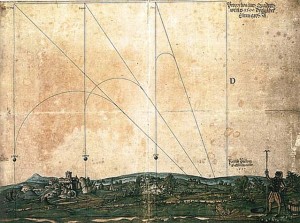
Steven Vogel is a biophysicist who thinks about how principles of physics show up in the design or behavior of biological organisms. For instance, organisms that jump or throw use projectile motion, which we talk about extensively in introductory mechanics.
Starting from the standard picture of projectile motion that you have learned, are learning, or will learn (Figure 1), Vogel points out that the smaller the organism, the worse the approximation of neglecting air resistance becomes. By the time you get to small seeds and spores, trajectories definitely do not look parabolic (Figure 2). Extensive information about spore ejection (probably more than you want to know), including 50,000 fps video of the process is available in this article and accompanying materials.

See Steven Vogel, “Living in a physical world II. The bio-ballistics of small projectiles” J. Biosci. 30:167-175 (2005) for full details.

Compare this to the lovingly rendered trajectories of cannonballs bombarding a peaceful hillside town, according to Aristotle’s theory. Aristotle gets the cannonball‘s trajectory completely wrong, but in the high-air-resistance limit (such as for Sordaria in Figure 2) he’s not so far off. Of course, Aristotle really is wrong about the physics, but when you add a lot of air resistance to gravity you happen to end up (coincidentally?) with something similar to Aristotle’s prediction. Lesson: you can safely ignore air resistance if you are a cannonball, but not if you are a spore.

